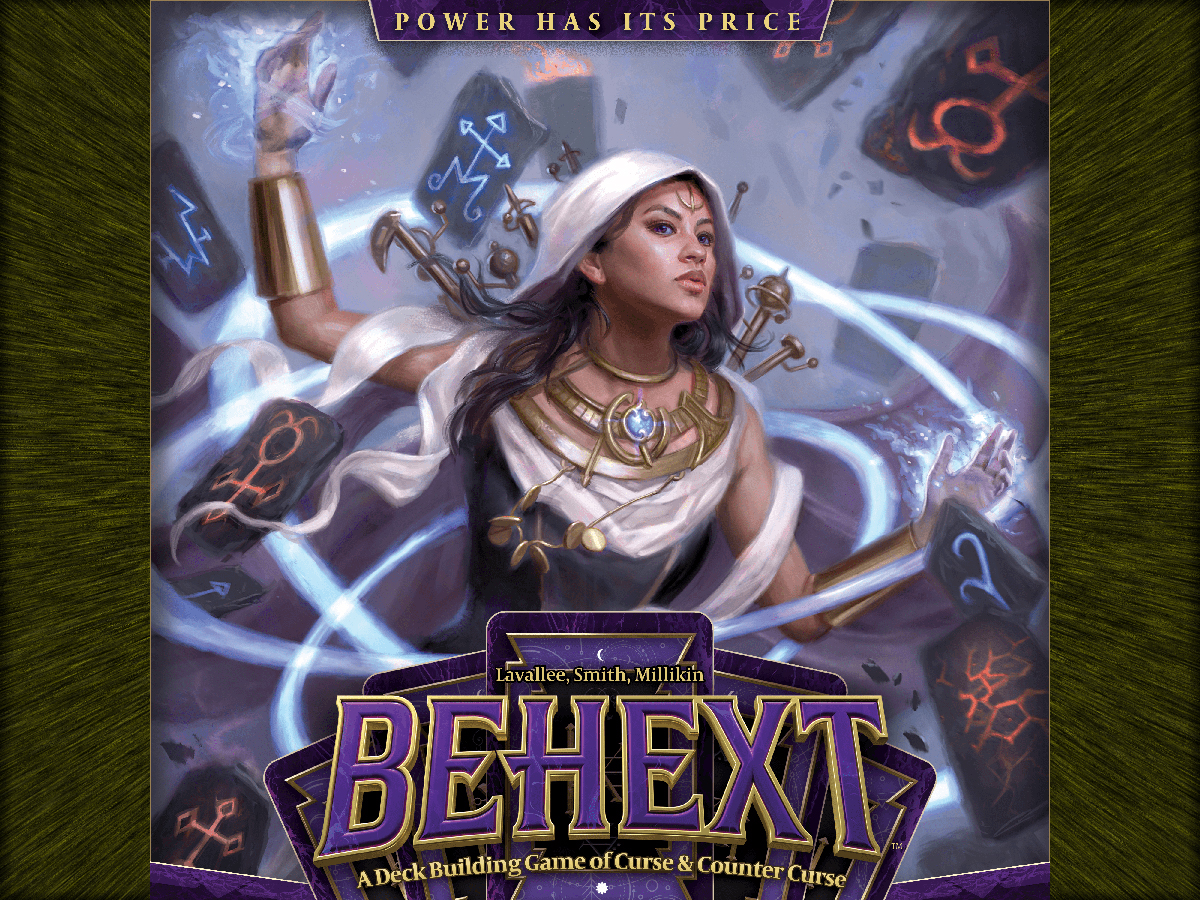Build up your library of spells as you deflect hexes thrown at you by your rivals.
What Is Behext?
Behext is a deck-building game for 3 to 5 players, ages 14 and up, and takes about 15 minutes per player. It’s currently seeking funding on Kickstarter, with a pledge level of $45 for a copy of the game. The age rating says 14 and up, but I think younger players who have some experience with other deck-building games shouldn’t have too much trouble learning this one, even though the deck-building in Behext is a bit different from other titles in the genre.
Behext was designed by Jonathan Lavallee, Melodee Smith, and Greg Millikin and published by Smirk & Dagger Games, with illustrations by Lindsey Look and graphic design by Curt Covert. It is based on Hex Hex, designed by Curt Covert.
New to Kickstarter? Check out our crowdfunding primer.
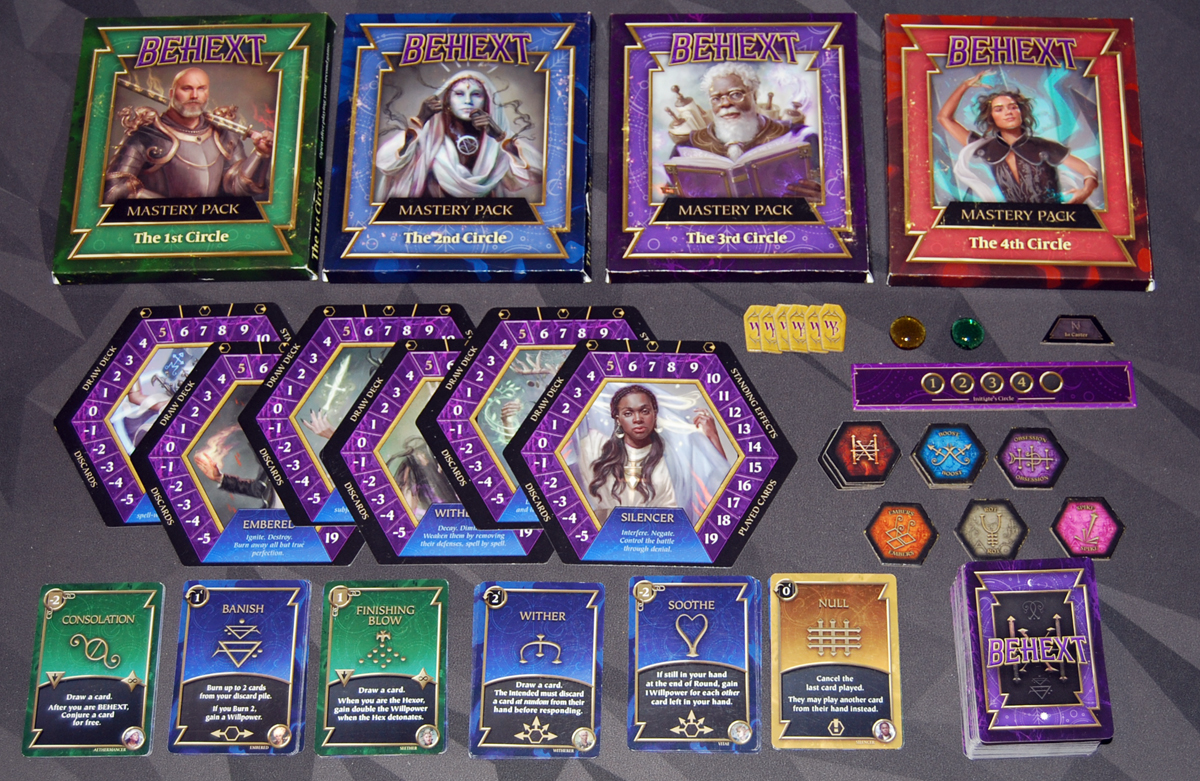
Behext Components
Note: My review is based on a prototype copy, so it is subject to change and may not reflect final component quality.
Here’s what comes in the box:
- 6 Battlemage play mats
- 6 Willpower markers
- 6 Battlemage decks (10 cards each)
- Round tracker
- 2 Round markers
- 1st Caster token
- 5 Hex tokens
- 10 Enhancement tokens
- 86 Spell cards
- 4 Mastery Packs (see below)

The battlemage mats are hexagonal, with a willpower track around the edge as well as labels to indicate where to place various cards. The center has an illustration of the character as well as the title and a brief description. The willpower tokens are sort of coffin-shaped and are just placed on the mat to track your willpower—be careful not to bump them! The portraits are nicely done and give some personality to the various mages, but that’s really the only thing in the game that is illustrated. Everything else uses icons and symbols.

The cards have gold symbols on the top half, inspired by alchemy symbols, and the background color gives an indication about the type of card it is. The bottom shows the direction you can send a hex, if the card can be used for that. Starting cards are indicated by a “Core” icon, and each battlemage also has three unique starting cards that have their portrait in the corner.
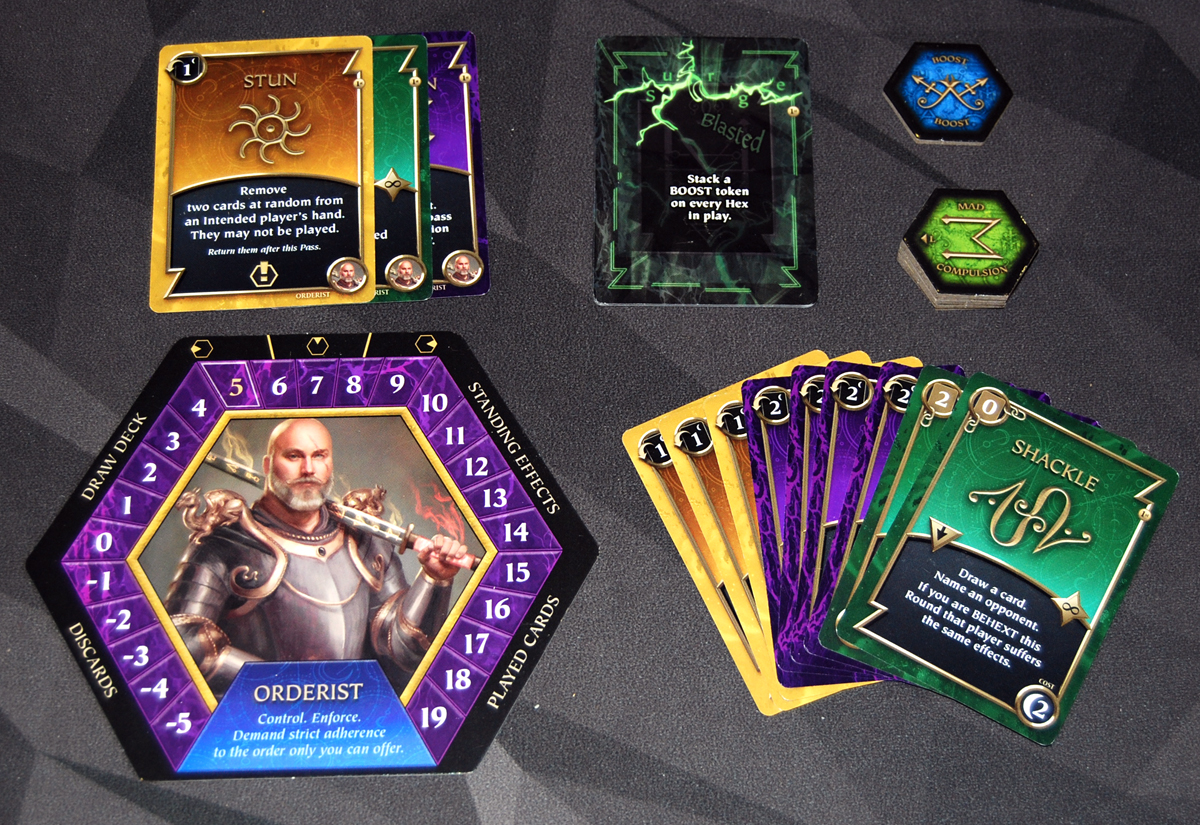
The Mastery Packs aren’t a mystery, but are intended to let you start with the basic rules and gradually introduce more complex interactions as everyone becomes familiar with the game. Each pack includes a new battlemage with its starting cards and some spell cards to shuffle into the main deck. Some of the packs also have additional components like new enhancement tokens. In all, it includes 43 additional spell cards, 4 battlemage play mats, and a pile of enhancement tokens.
How to Play Behext
You can download a copy of the rulebook here.
The Goal
The goal of the game is to score the most points by gaining (or retaining) willpower and conjuring certain spells.
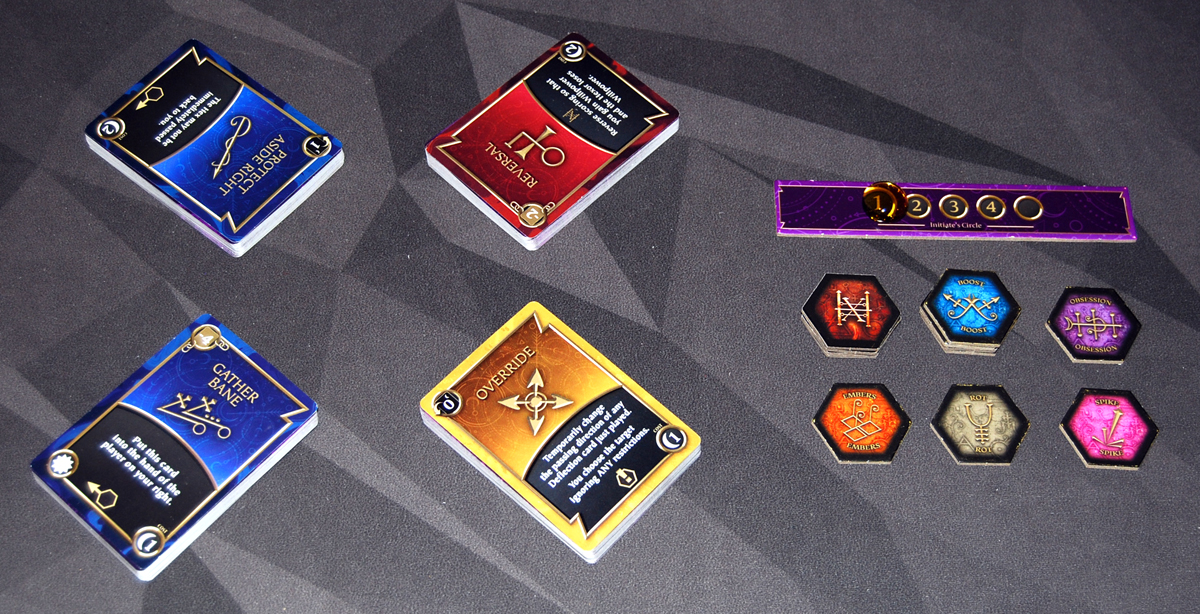
Setup
Each player chooses a battlemage and takes the play mat, 10-card starting deck, and a willpower token (set at “5” on the track). Everyone shuffles their own deck and draws 5 cards. Choose a starting player and give them the 1st Caster token.
Shuffle the spell deck, and divide it into 4 roughly equal stacks, placing the four stacks in the center of the playing area to form the conjuring wheel. Flip the top card of each stack face-up.
Place the round tracker nearby with the marker on Round 1.
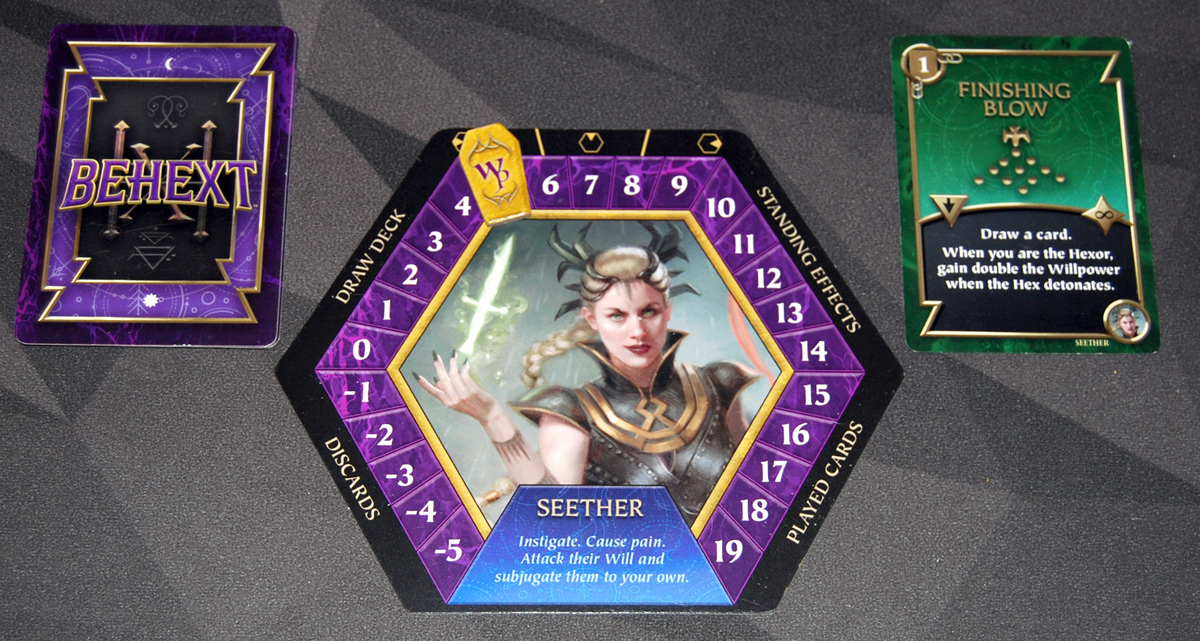
Gameplay
Unlike many games, there isn’t a prescribed turn order in Behext. Instead, the player who receives a hex takes the next turn. At the start of the round, the 1st Caster takes a hex token and gives it to any opponent (without playing a card).
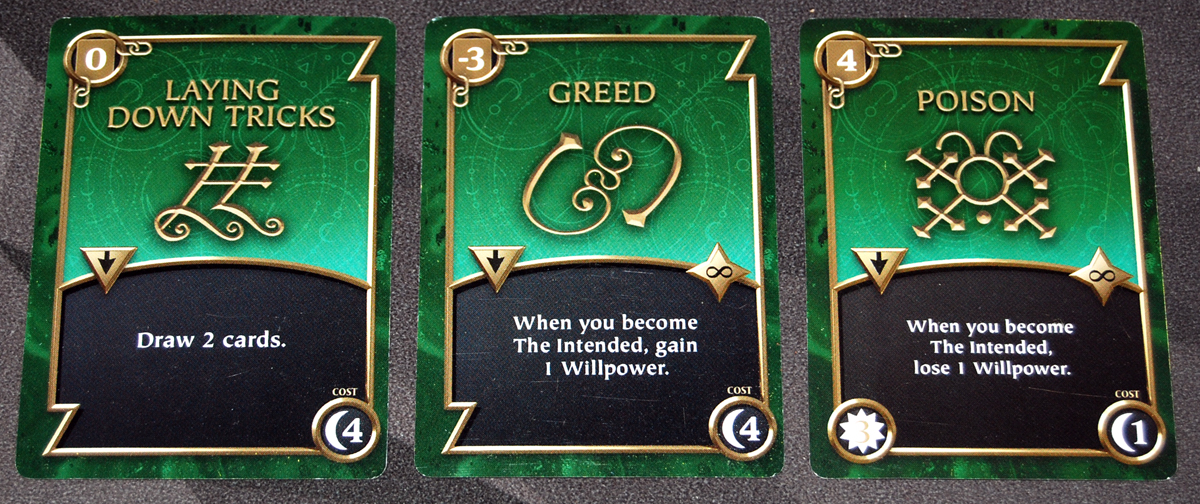
Green cards are charms and must be played as soon as they’re drawn (or conjured). They typically stay in play until the end of a round.
If you’ve been sent a hex, you are the “Intended.” You may first optionally conjure a new spell (to gain a new card), and then you must play a card to deflect the hex.
To conjure a spell, you must discard cards from your hand to meet the cost of a spell in the conjuring wheel. You may optionally spend up to 1 willpower to reduce the cost by 1, but you must always discard at least 1 card in order to conjure. The newly conjured spell is placed in your hand, and a new card is flipped face-up in the wheel.

Then, you must play a card from your hand to deflect the hex. Most deflections are blue cards, and the icon at the bottom indicates whether the hex is passed left, right, across, or in any direction of your choice; many of these cards also have additional effects. Purple cards are enhanced deflections: they pass the hex and add an enhancement token that will have additional effects.
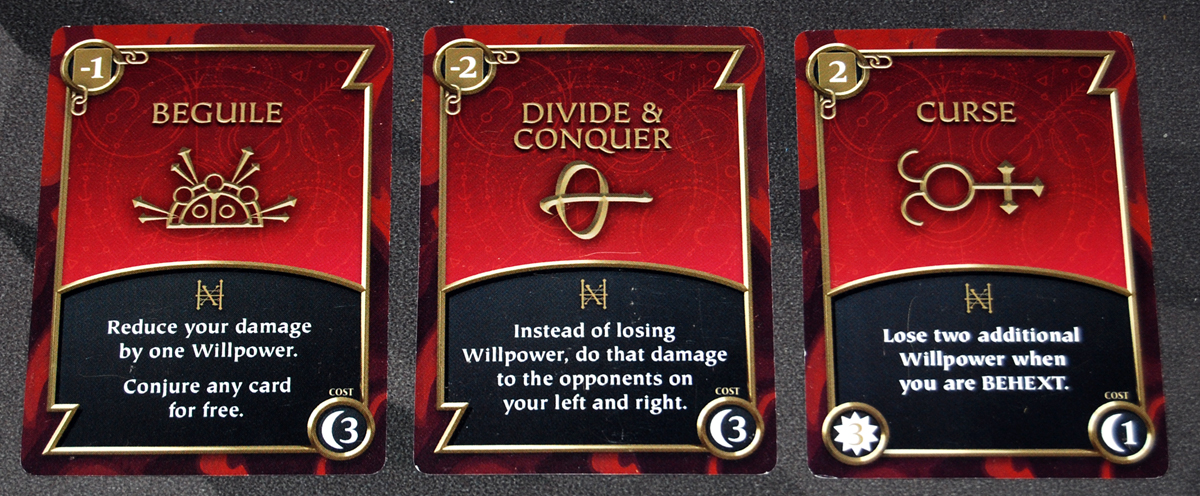
The round continues until somebody is unable to deflect the hex—the hex blows up and that player is “Behext.” If you’re Behext and you have any red cards in your hand, you must play one of them. Some have positive effects and some have negative effects. The Hexor (the person who sent the hex) gains 1 willpower, and the Behext player loses 1 willpower. Sometimes enhancements or other cards may have additional effects. Also, any non-Behext players who have played one or fewer deflection cards this round gains 2 willpower.
If the game hasn’t ended, then it’s time for the gathering: each player, starting with the first player, may conjure one spell using the remaining cards in their hands plus any charms they have in play. Some cards have chain icons in the top left—these may only be spent during the gathering phase and cannot be used to conjure during the main part of the round. Then, burn (return to the box) the top card of each deck in the conjuring wheel. Pass the 1st Caster token to the left and start a new round.
Game End
The game ends after the last round—for the initial games, that’s 4 rounds.
Each player scores 1 point per willpower, plus the point values of any cards they have in their deck. Highest score wins, with ties going to the player with the most willpower, then the highest total conjuring cost of their decks, and then the player with the fewest core cards in their deck.
Mastery Packs
Each Mastery Pack adds to the game incrementally, with a small rulesheet included. It’s recommended to add the first pack after your second game, and then add more as players become familiar enough with the cards to recognize them by their symbols without having to read everything each time.

One significant change added in the first Mastery Pack is the variable game length: the round tracker is flipped over to a side showing 9 rounds. One round tracker is placed on Round 1, and the other on Round 9. There are cards mixed into the conjuring wheel that have special effects when revealed, including moving the end tracker back, so you don’t know in advance exactly how many rounds the game will take.
Why You Should Play Behext
Way back in 2011, I reviewed a game called Hex Hex XL, an expanded version of the game that launched Smirk & Dagger. The cards have similar symbols and names, and were used to bounce a hex around until it detonated. The big difference, though, was that it wasn’t a deck-building game: you just started with 5 cards drawn from the deck each round, and there wasn’t any “conjuring” of new cards—you just drew cards from the deck if you had an effect that allowed it. It was a lot of raucous fun, but didn’t feel like it allowed for much strategic planning. Sometimes you got a good hand and sometimes you didn’t, but each round was going to be a totally random event.
Lavallee, Smith, and Millikin have taken Covert’s initial design and turned it into a deck-building game, with some surprising results. First, the deck-building lets you do some planning, because you have an opportunity to build your deck. You want to just make sure you don’t get Behext? Buy a lot of deflection cards. You like taking risks to gain rewards? Try the red cards: some will make the detonation worse if it hits you, but the card itself is worth points.

Second, the starting decks mean that there’s a little more balance right from the start. Everyone has the same 7 core deflection cards (two each pass left and right and across, and one pass across that also lets you draw a card), and then three cards that are unique to the character. That means that within the first two rounds you’re guaranteed to have plenty of basic deflections, and you’re not going to be stuck as a sitting duck because you drew a bunch of charms and have nothing left to defend yourself.
The starting decks also give you a nudge toward one strategy, though they don’t lock you into it. The mages have different strengths: conjuring, burning (trashing cards from your system), gaining willpower, forcing opponents to discard, and so on. If you like a particular strategy, you can go for that mage, but you can also rebalance your deck based on what you conjure over the course of the game.
Another advantage of the deck-building is that you generally will never get stuck with a card you didn’t choose for yourself. There are some cards that have negative effects, and in the original Hex Hex game, if you drew one you were just stuck with it. Here, if it’s in your hand, it’s because you conjured it, usually because the card is also worth points. You get to decide whether the points are a big enough incentive to take the risk.
The deck-building aspect also introduces a tough choice each time you’re the intended: do you spend cards (and willpower) to build your deck, or do you hang onto the cards you have to protect yourself? The conjuring wheel is almost like an extension of your hand, because on your turn you could conjure a card and play it immediately. However, if you discard a lot of cards to buy something expensive, you’ll be an easy target the next time the hex comes back to you. And while spending willpower can boost your buying power without losing cards, remember that willpower is worth points!
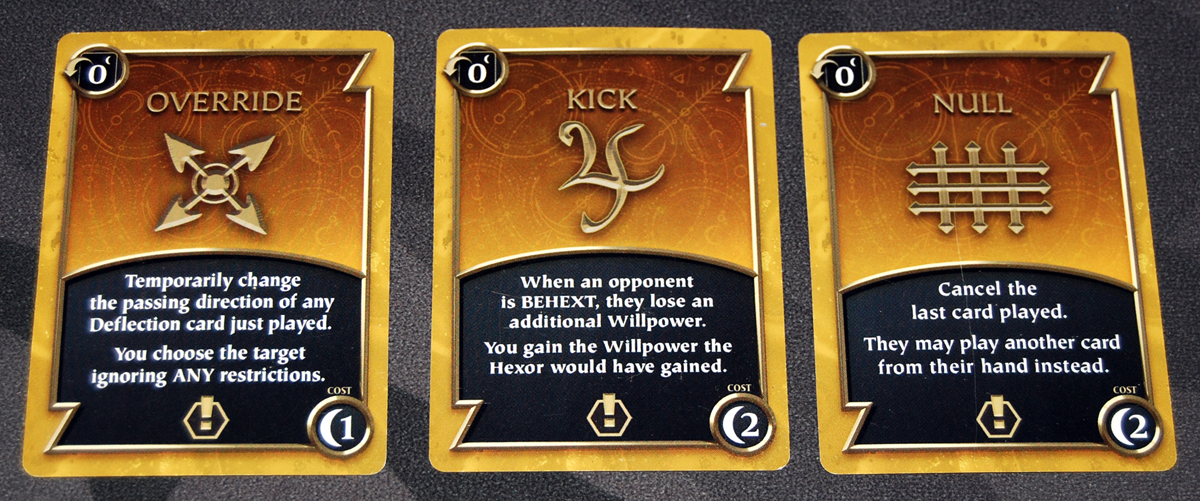
As a deck-building game, Behext has a different feel from most deck-building games because of the way the turn order works. In most deck-building games, you play all of your cards during your turn, maybe buy some cards, and then discard everything and draw a new hand. It’s less common—though not unheard of—for players to play only one card per turn, and for the game to be structured in rounds, when everyone will draw a new hand of cards. In Behext, not only do you only play one card per turn, but the turn order is not predetermined: it’s simply based on who receives the hex. It does mean that two players with a vendetta could end up sending it back and forth to each other and leave out the rest of the players, but it’s generally not a good idea because those other players will just get free willpower. On the other hand, the number of turns you get also determines how many times you get to conjure (buy) cards each round.
One weakness I spotted, common in deck-builders, is that the game can feel different simply based on which cards happen to appear in the market. Since it’s a big stack, chances are you won’t go through the entire deck, so you can’t always plan on getting a particular card for your strategy. Sometimes there are a lot of charms that turn up; sometimes none of the cards with victory points show up. There’s not really a good way to guarantee that the market will be balanced—but that’s not a problem unique to Behext, either. As you add the Master Packs, though, you’ll get more cards that aren’t basic deflections, so it does get more interesting as you progress.
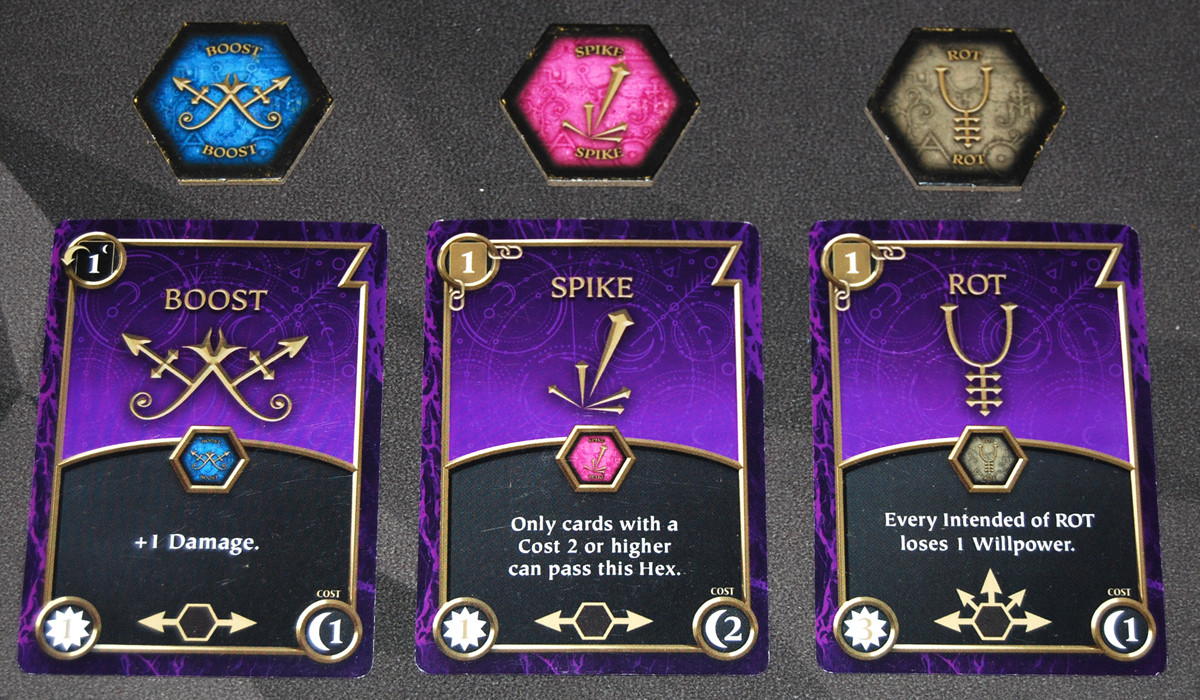
generally makes it worse. (Prototype shown) Photo: Jonathan H. Liu
The hex enhancements are a fun risk-reward feature, too: they do things like increase the damage done, reduce willpower every time the hex is received, force players to discard cards, and more. In some of the later Mastery Packs, there are even enhancements that will multiply the hexes so you could have several hexes bouncing around the table at once. Of course, making a hex more powerful doesn’t mean that it won’t come back to bite you. It reminds me a little of the “Dynamite” card in Bang!: sure, you can light the fuse and it will do a whopping amount of damage to somebody, but there’s a chance you might just blow yourself up instead. And in Behext, of course, if you put a nasty boost on a hex, sometimes players can just keep sending it directly back to you.
Behext does a good job of giving you the feeling of mages slinging spells at each other: the symbols on the card call to mind Doctor Strange’s magical shields as you deflect the hex and direct it at somebody else. To me, the deck-building version adds some strategy that was missing in the original, which I enjoy. The initial game can feel a little short at 4 rounds, simply because you may not have as much time to build up an engine and use some of your conjured cards many times before the game ends. However, once you switch to the variable length game, it gives you some more time to craft your arsenal.
If you enjoy deck-building and you prefer a touch of “take that” in your games, Behext is worth taking a closer look. For more information or to make a pledge, visit the Behext Kickstarter page!
Click here to see all our tabletop game reviews.
![]() To subscribe to GeekDad’s tabletop gaming coverage, please copy this link and add it to your RSS reader.
To subscribe to GeekDad’s tabletop gaming coverage, please copy this link and add it to your RSS reader.
Disclosure: GeekDad received a prototype of this game for review purposes.
